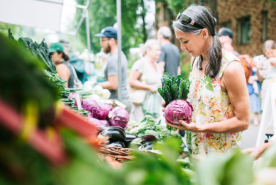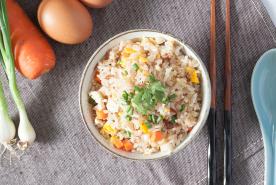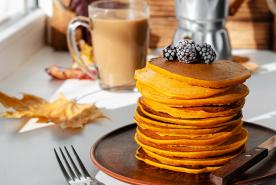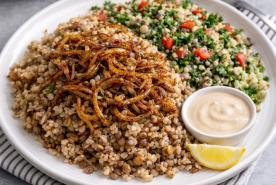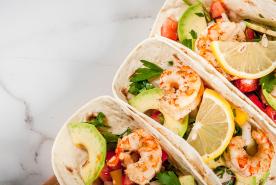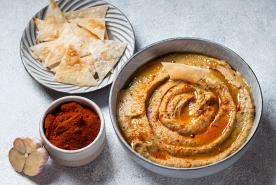November 18, 2024
Seguir tus límites de líquidos en diálisis puede ser un desafío. Descubre estrategias prácticas, sustitutos inteligentes y apoyo emocional con la National Kidney Foundation.
Por qué es importante seguir tus restricciones de líquidos
Adaptarse a las restricciones de líquidos puede ser un reto, pero con apoyo y compromiso puedes lograrlo.
Cuando los riñones ya no pueden equilibrar los líquidos del cuerpo, el exceso puede acumularse y causar dificultad para respirar, hinchazón o presión en el corazón.
Seguir tu límite de líquidos ayuda a prevenir la sobrecarga de fluidos, mejora tu bienestar y reduce el riesgo de presión arterial baja, calambres y fatiga durante la diálisis.
Completa nuestro cuestionario para saber si la diálisis en casa es adecuada para ti.
Divide tu consumo diario
Una forma práctica de mantenerte dentro de tu límite es distribuir tu consumo durante el día.
Por ejemplo, si tu límite diario es de 32 onzas (aprox. 1 litro), puedes dividirlo en cuatro porciones de 8 onzas: a las 10 a. m., 2 p. m., 6 p. m. y 10 p. m.
Si prefieres llevar un registro, usa una libreta o una aplicación como H2Overload, diseñada para personas con enfermedad renal o cardíaca que necesitan controlar la ingesta de líquidos.
Habla con tu equipo de diálisis para ajustar el horario a tu rutina y tus necesidades.
¿Buscas más información?
Únete a nuestra comunidad
Mantente conectado y accede a recursos adicionales relacionados con la enfermedad renal.
Encuentra sustitutos inteligentes
Además de estos sustitutos, puedes crear tus propias estrategias según lo que más te funcione en el día a día. Por ejemplo, algunas personas encuentran alivio chupando rodajas de limón o usando esencias aromáticas como menta o eucalipto para reducir la sensación de sequedad. Incluso pequeños cambios en tu rutina —como mantener la boca húmeda, respirar por la nariz o evitar bebidas muy calientes— pueden ayudarte a controlar mejor los momentos de mayor sed.
Otra táctica efectiva es identificar los momentos del día en los que suele darte más sed y planificar sustitutos específicos para ese horario. Si sabes que después de las comidas necesitas algo refrescante, prepara por adelantado fruta congelada o cubos de hielo saborizados. Si la sed aparece por la noche, mantén a mano caramelos sin azúcar o enjuague bucal. Estas herramientas te permiten mantenerte dentro del límite de líquidos sin sentir que estás renunciando a la comodidad o al sabor.
Cuando sientas sed, prueba opciones refrescantes sin aumentar el consumo de líquidos:
- Usa enjuague bucal o caramelos duros (menta, limón o ácidos) para estimular la saliva y aliviar la sensación de sed.
- Mastica cubos de hielo o fruta congelada (como uvas, fresas o arándanos). Un cubo equivale aproximadamente a la mitad de agua en volumen, así que puedes darte el gusto sin pasarte del límite.
- Congela jugo 100 % natural sin azúcar añadido como alternativa sabrosa y controlada.
Descubre más ideas en nuestras recetas amigables para diálisis (ideas de comidas bajas en sodio, potasio y fósforo).
Reduce el sodio
Reducir el sodio no solo ayuda a evitar la sed, también hace que tus sesiones de diálisis sean más cómodas. Cuando el cuerpo retiene menos sal, también retiene menos líquido, lo que disminuye la hinchazón, la presión alta y la sensación de pesadez. Muchas personas descubren que, al bajar el sodio de manera constante, tienen menos calambres y menos bajones de presión durante el tratamiento. Es un cambio pequeño que impacta muchísimo en cómo te sientes día a día.
¿Cuánto sodio es seguro para los pacientes renales?
Otra recomendación útil es acostumbrarte a cocinar más en casa. Así controlas exactamente qué ingredientes usas y puedes experimentar con combinaciones de hierbas y especias que realcen el sabor sin necesidad de sal. Preparar tus propios aderezos, salsas o sazonadores puede marcar la diferencia. También puedes preparar comidas en lotes y congelarlas para evitar recurrir a productos procesados (que suelen ser muy altos en sodio) cuando tengas prisa o estés cansado. Con el tiempo, tu paladar se acostumbra y notarás que los alimentos con mucha sal empezarán a saber demasiado fuertes.
Cocinando con presupuesto para la salud renal.
El sodio (sal) ayuda al cuerpo a equilibrar el agua, pero en exceso puede causar sed, aumento de líquidos, hipertensión y malestar durante la diálisis.
Consejos para reducirlo:
- Sustituye la sal por hierbas y especias frescas como ajo, cebolla, pimienta negra, jugo de limón o vinagre.
- Lee las etiquetas: si la sal aparece entre los primeros cinco ingredientes, probablemente contiene demasiado sodio.
- En restaurantes, pide que preparen tus comidas sin sal añadida y solicita las salsas aparte.
- Si debes controlar el potasio, revisa los sustitutos de sal y alimentos “bajos en sodio”, ya que muchos contienen potasio en exceso.
Consulta a un dietista renal para obtener orientación personalizada.
Busca apoyo
Adaptarte a una nueva rutina de líquidos puede ser frustrante, pero no estás solo.
El programa NKF Peers en español conecta a personas en diálisis con mentores capacitados que también han pasado por esta etapa.
Ellos pueden ofrecerte apoyo emocional, consejos prácticos y la motivación que necesitas para mantener hábitos saludables y disfrutar de una mejor calidad de vida.
Responde a nuestro breve cuestionario para saber si la diálisis en casa es adecuada para ti.
Takeaways: puntos clave para recordar
- Controlar los líquidos ayuda a prevenir la hinchazón, la dificultad respiratoria y la sobrecarga del corazón.
- Divide tu consumo diario y usa una app o libreta para registrar tu progreso.
- Engaña la sed con cubos de hielo, caramelos o frutas congeladas.
- Reduce la sal y reemplázala con especias y hierbas naturales.
- Consulta a tu dietista renal o descarga herramientas como H2Overload para mantenerte en control.
- Busca apoyo con un mentor de NKF Peers en español: compartir tu experiencia puede marcar la diferencia

